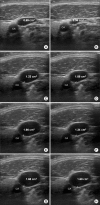The simultaneous application of positive-end expiratory pressure with the Trendelenburg position minimizes respiratory fluctuations in internal jugular vein size
- PMID: 24910725
- PMCID: PMC4041952
- DOI: 10.4097/kjae.2014.66.5.346
The simultaneous application of positive-end expiratory pressure with the Trendelenburg position minimizes respiratory fluctuations in internal jugular vein size
Abstract
Background: The respiratory cycle alters the size of the right internal jugular vein (RIJV). We assessed the changes in RIJV size during the respiratory cycle in patients under positive pressure ventilation. Moreover, we examined the effects of positive-end expiratory pressure (PEEP) and the Trendelenburg position on respiratory fluctuations.
Methods: A prospective study of 24 patients undergoing general endotracheal anesthesia was performed. Images of the RIJV were obtained in the supine position with no PEEP (baseline, S0) and after applying three different maneuvers in random order: (1) a PEEP of 10 cmH2O (S10), (2) a 10° Trendelenburg tilt position (T0), and (3) a 10° Trendelenburg tilt position combined with a PEEP of 10 cmH2O (T10). Using the images when the area was smallest and largest, cross-sectional area (CSA), anteroposterior diameter, and transverse diameter were measured.
Results: All maneuvers minimized the fluctuation in RIJV size (all P = 0.0004). During the respiratory cycle, the smallest CSA compared to the largest CSA at S0, S10, T0, and T10 decreased by 28.3 8.5, 8.0, and 4.4%, respectively. Furthermore, compared to S0, a 10° Trendelenburg tilt position with a PEEP of 10 cmH2O significantly increased the CSA in the largest areas by 83.8% and in the smallest areas by 169.4%.
Conclusions: A 10° Trendelenburg tilt position combined with a PEEP of 10 cmH2O not only increases the size of the RIJV but also reduces fluctuation by the respiratory cycle.
Keywords: Cross-sectional area; Internal jugular vein; Positive end-expiratory pressure; Trendelenburg position.
Figures

References
-
- Miller RD. Miller's anesthesia. 7th ed. New York: Churchill Livingstone; 2009. pp. 1285–1286.
-
- Shah KB, Rao TL, Laughlin S, El-Etr AA. A review of pulmonary artery catheterization in 6,245 patients. Anesthesiology. 1984;61:271–275. - PubMed
-
- Goldfarb G, Lebrec D. Percutaneous cannulation of the internal jugular vein in patients with coagulopathies: an experience based on 1,000 attempts. Anesthesiology. 1982;56:321–323. - PubMed
-
- Heath KJ, Woulfe J, Lownie S, Pelz D, Munoz DG, Mezon B. A devastating complication of inadvertent carotid artery puncture. Anesthesiology. 1998;89:1273–1275. - PubMed
-
- Reuber M, Dunkley LA, Turton EP, Bell MD, Bamford JM. Stroke after internal jugular venous cannulation. Acta Neurol Scand. 2002;105:235–239. - PubMed
LinkOut - more resources
Full Text Sources
Other Literature Sources
Research Materials

